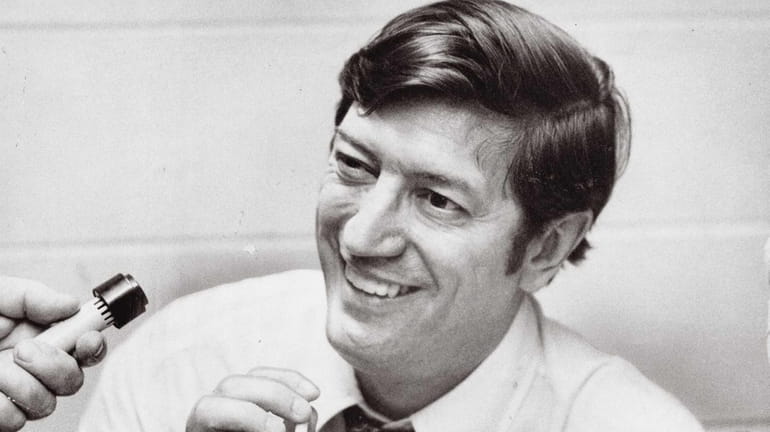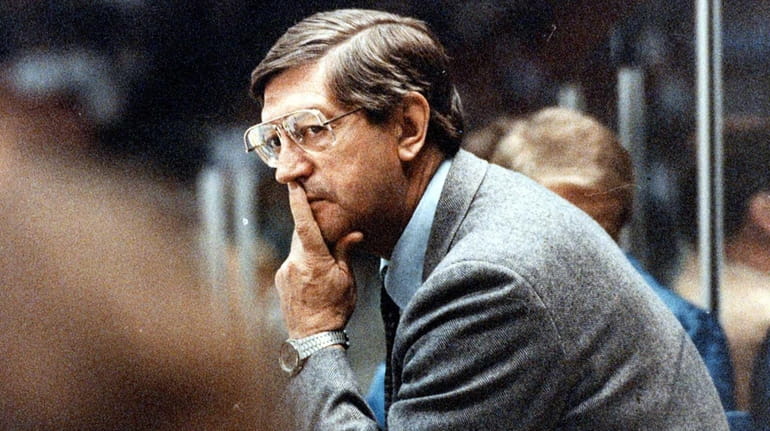It wasn't Seventh Avenue, but Al Arbour put Islanders on hockey map

Islanders coach Al Arbour talks in the dressing room after a game at the Nassau Coliseum. Credit: Newsday, 1975
Forty years ago this week, the Islanders were girding for greatness.
Oh, they didn't know it, of course. They were winding up their first training camp under Al Arbour, a guy with glasses known variously as "Radar," for "M*A*S*H" character Radar O'Reilly, and "Barney Google," a banjo-eyed comic strip character. And they were practicing in Peterborough -- you know, in Ontario.
Arbour brought in 91 -- count 'em, 91 -- players. He didn't know who the heck they were. In fact, he pinned their names on pieces of paper on the backs of their jerseys so he'd have a smidgen of an idea who they were.
But then again, when your team, a second-year expansion club, is coming off the worst season in National Hockey League history, winning 12 of 78 games, it's out with the old and in with the new.
Arbour spoke funny. He actually used the word "playoffs," saying he had never missed one in 19 years as a player and coach and that he expected to make it with this team.
Well, they didn't quite. But Arbour, who was hired to replace Earl Ingarfield, who had replaced Phil Goyette, set a tone, demanding accountability and effort and, above all, results.
"I don't want to hear about yesterday," he told the players. "I want to hear about today, tomorrow and the future."
The rest is history. In a way, it's also somewhat sad as the Islanders' nostalgia ship takes off on its next-to-last season before moving to Brooklyn.
Still, I had no idea back then. How could anyone? Why, when the Rangers played at the Coliseum, the cheers for the Rangers drowned out the suburbanite fans.
Arbour was not your usual hockey strategist. Hockey still was a sport from another era. The coach oversaw everything and everyone -- from the trainer's room to the goalie to the defensemen to the forwards.
One day during that first summer, Arbour invited me to a meeting he was having with Jets coach Weeb Ewbank. The Jets trained nearby in Hempstead. Arbour also brought with him a rookie named Denis Potvin, a husky guy who smoked a Sherlock Holmes meerschaum pipe and was all of 19 years old -- and the most acclaimed young player in the hockey world since Bobby Orr.
"I want to know how football teams use films and their conditioning methods," Arbour explained. "I want to know how they coach the different positions."
This was a radical thought back then. He was going to look at new and innovative ways to produce a winner.
Ewbank, for his part, said he was surprised at how small hockey players looked in person. And he virtually admonished Arbour and Potvin at the size of Potvin's contract -- $300,000 for three years. "Hockey will suffer if they don't stop those big contracts," said the parsimonious Ewbank, who also was the Jets' general manager.
After the meeting, Potvin asked me, "Excuse my ignorance, but who was that man Weeb we were talking to?"
When Isles general manager Bill Torrey heard about Potvin's question, he told the rookie, "Lookit, Denis, if you want to be a New Yorker, you better know who the Super Bowl coach of the Jets was."
It's funny how naive, in a way, it all seems now. Arbour told me that when he was first contacted by Torrey, he turned him down. Why?
"I thought I'd be living on Seventh Avenue," Arbour said. He didn't realize the Islanders were not playing in midtown Manhattan but in the suburbs.
This time Torrey actually showed him Long Island. They went for a ride on the North Shore. Arbour liked what he saw.
Meanwhile, a lot of his players had in fact been living in Manhattan and commuting to the Island. Others left their families back in Ontario or Alberta, where their young kids were in school. Now, in their second season, they were looking to rent on the Island and become part of the community.
"We seem to know where we're going now," said the Islanders' insightful defenseman, Gerry Hart.
Well, they didn't win much in Arbour's first season, but they made the playoffs the next year (1974-75) and every year after until 1988.
That first playoff series victory changed the mind-set of the players and the fans. For it came against, of all teams, the Rangers. It meant that these suburban rubes actually were better than the Manhattanites. And to me, that is the essence of what makes a great rivalry: an underdog against an establishment type. It was the essence of the Dodgers against the Yankees, the Jets against the Giants and the Islanders against the Rangers.
Before we know it, these Islanders, the legacy of that collection of mostly unknowns in Peterborough, Ontario, will be playing in downtown Brooklyn -- at least near an LIRR station. And I wonder whether they will remember those years on Long Island, the only major-league team the place had for so long, and a coach and a player who brought it greatness, finally learning where Uniondale was.
Gerald Eskenazi covered the Islanders and Rangers among his 8,000 bylines in The New York Times. He was present at the creation of the Islanders and the Coliseum. In addition, he has written 16 books and lectures on sports and the news media. He lived in Roslyn for 35 years before moving to New York City.

